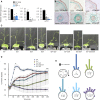The Arabidopsis LAZY1 Family Plays a Key Role in Gravity Signaling within Statocytes and in Branch Angle Control of Roots and Shoots
- PMID: 28765510
- PMCID: PMC5590491
- DOI: 10.1105/tpc.16.00575
The Arabidopsis LAZY1 Family Plays a Key Role in Gravity Signaling within Statocytes and in Branch Angle Control of Roots and Shoots
Abstract
During gravitropism, the directional signal of gravity is perceived by gravity-sensing cells called statocytes, leading to asymmetric distribution of auxin in the responding organs. To identify the genes involved in gravity signaling in statocytes, we performed transcriptome analyses of statocyte-deficient Arabidopsis thaliana mutants and found two candidates from the LAZY1 family, AtLAZY1/LAZY1-LIKE1 (LZY1) and AtDRO3/AtNGR1/LZY2 We showed that LZY1, LZY2, and a paralog AtDRO1/AtNGR2/LZY3 are redundantly involved in gravitropism of the inflorescence stem, hypocotyl, and root. Mutations of LZY genes affected early processes in gravity signal transduction without affecting amyloplast sedimentation. Statocyte-specific expression of LZY genes rescued the mutant phenotype, suggesting that LZY genes mediate gravity signaling in statocytes downstream of amyloplast displacement, leading to the generation of asymmetric auxin distribution in gravity-responding organs. We also found that lzy mutations reversed the growth angle of lateral branches and roots. Moreover, expression of the conserved C-terminal region of LZY proteins also reversed the growth direction of primary roots in the lzy mutant background. In lateral root tips of lzy multiple mutants, asymmetric distribution of PIN3 and auxin response were reversed, suggesting that LZY genes regulate the direction of polar auxin transport in response to gravity through the control of asymmetric PIN3 expression in the root cap columella.
© 2017 American Society of Plant Biologists. All rights reserved.
Figures






Similar articles
-
Polar recruitment of RLD by LAZY1-like protein during gravity signaling in root branch angle control.Nat Commun. 2020 Jan 3;11(1):76. doi: 10.1038/s41467-019-13729-7. Nat Commun. 2020. PMID: 31900388 Free PMC article.
-
ARL2, ARG1 and PIN3 define a gravity signal transduction pathway in root statocytes.Plant J. 2008 Jan;53(2):380-92. doi: 10.1111/j.1365-313X.2007.03351.x. Epub 2007 Nov 28. Plant J. 2008. PMID: 18047472
-
LAZY Genes Mediate the Effects of Gravity on Auxin Gradients and Plant Architecture.Plant Physiol. 2017 Oct;175(2):959-969. doi: 10.1104/pp.17.00942. Epub 2017 Aug 18. Plant Physiol. 2017. PMID: 28821594 Free PMC article.
-
Gravity sensing and signaling.Curr Opin Plant Biol. 2004 Dec;7(6):712-8. doi: 10.1016/j.pbi.2004.09.001. Curr Opin Plant Biol. 2004. PMID: 15491921 Review.
-
Bridging the gap between amyloplasts and directional auxin transport in plant gravitropism.Curr Opin Plant Biol. 2019 Dec;52:54-60. doi: 10.1016/j.pbi.2019.07.005. Epub 2019 Aug 23. Curr Opin Plant Biol. 2019. PMID: 31446250 Review.
Cited by
-
ENHANCED GRAVITROPISM 2 encodes a STERILE ALPHA MOTIF-containing protein that controls root growth angle in barley and wheat.Proc Natl Acad Sci U S A. 2021 Aug 31;118(35):e2101526118. doi: 10.1073/pnas.2101526118. Proc Natl Acad Sci U S A. 2021. PMID: 34446550 Free PMC article.
-
Rapid translocation of NGR proteins driving polarization of PIN-activating D6 protein kinase during root gravitropism.Elife. 2024 Mar 5;12:RP91523. doi: 10.7554/eLife.91523. Elife. 2024. PMID: 38441122 Free PMC article.
-
Gravity sensing in plant and animal cells.NPJ Microgravity. 2021 Feb 8;7(1):2. doi: 10.1038/s41526-020-00130-8. NPJ Microgravity. 2021. PMID: 33558517 Free PMC article. Review.
-
Exploring plant responses to altered gravity for advancing space agriculture.Plant Commun. 2025 Jun 9;6(6):101370. doi: 10.1016/j.xplc.2025.101370. Epub 2025 May 9. Plant Commun. 2025. PMID: 40349110 Free PMC article. Review.
-
BRXL4-LAZY1 interaction at the plasma membrane controls Arabidopsis branch angle and gravitropism.Plant J. 2023 Jan;113(2):211-224. doi: 10.1111/tpj.16055. Epub 2022 Dec 24. Plant J. 2023. PMID: 36478485 Free PMC article.
References
-
- Alonso J.M., et al. (2003). Genome-wide insertional mutagenesis of Arabidopsis thaliana. Science 301: 653–657. - PubMed
-
- Bennett M.J., Marchant A., Green H.G., May S.T., Ward S.P., Millner P.A., Walker A.R., Schulz B., Feldmann K.A. (1996). Arabidopsis AUX1 gene: a permease-like regulator of root gravitropism. Science 273: 948–950. - PubMed
-
- Blancaflor E.B. (2013). Regulation of plant gravity sensing and signaling by the actin cytoskeleton. Am. J. Bot. 100: 143–152. - PubMed
MeSH terms
Substances
LinkOut - more resources
Full Text Sources
Other Literature Sources
Molecular Biology Databases
Miscellaneous

